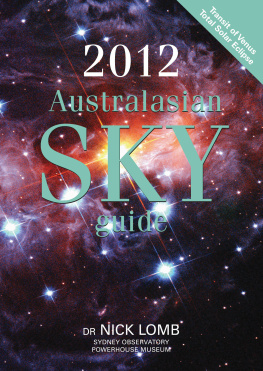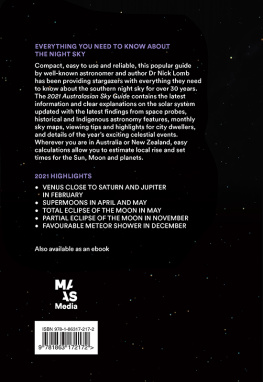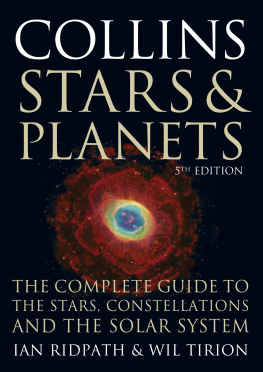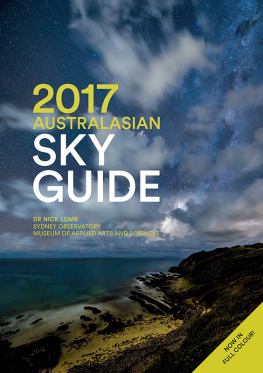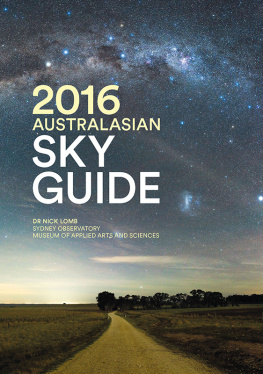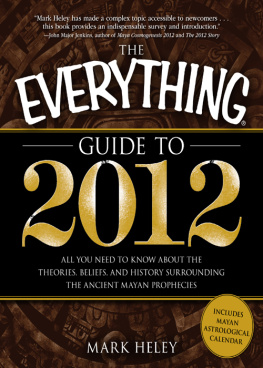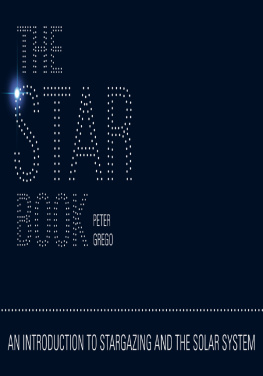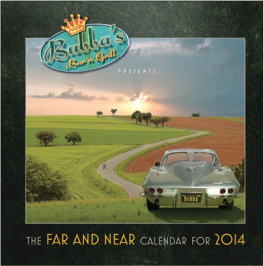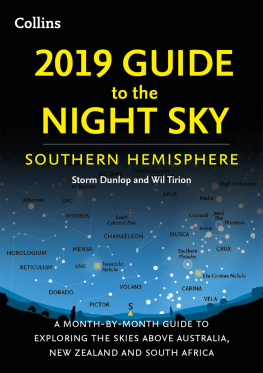2012
Australasian
SKY
guide
DR NICK LOMB
CONSULTANT CURATOR OF ASTRONOMY
SYDNEY OBSERVATORY
POWERHOUSE MUSEUM

Published annually since 1991 by Powerhouse Publishing PO Box K346 Haymarket 1238 www.powerhousemuseum.com/publications
PUBLICATION EDITOR
Tracy Goulding
DESKTOP PUBLISHING Anne Slam
DIAGRAMS AND ILLUSTRATIONS
Andy Chong/Picture This
COVER DESIGN i2i Design
PRINTING Ligare
ISBN 978 1 86317 137 3
ISSN 1039-3048
2011 Trustees of the Powerhouse Museum.
The Powerhouse Museum and Sydney Observatory are part of the Museum of Applied Arts and Sciences funded by the NSW government.
This book is copyright. Apart from fair dealing for the purposes of study, research, criticism or review, or as otherwise permitted under the Copyright Act, no part of this publication may be reproduced by any process without written permission. Inquiries should be made to the publisher.
The author wishes to acknowledge the assistance and contributions made by staff at Sydney Observatory. The original monthly sky maps were prepared by Rod Somerville using the program Skymap.
All material is supplied in good faith and is believed to be correct. It is supplied on the condition that no warranty is given in relation thereto and no responsibility or liability for error or omission is, or will, be accepted.
At the time of publication, Daylight Saving Time ends in NSW, ACT, Victoria, South Australia, Tasmania and New Zealand at 3:00 am on Sunday 1 April 2012, when clocks should be turned back to 2:00 am. Daylight Saving Time begins again at 2:00 am on Sunday 30 September 2012 in New Zealand and at 2:00 am on Sunday 7 October 2012 in the relevant Australian states. The information in this publication has been adjusted for summer time using the above times and dates.
The tide predictions for Sydney (Fort Denison) have been formatted by Powerhouse Publishing from material supplied by the National Tidal Centre (NTC). Users of these tables should be aware that the heights shown in this publication are predictions only and that the actual water level height may vary due to meteorological conditions (including barometric pressure, wind effect and storm surges) and seasonal variations.
For astronomical information required for legal purposes contact:
National Mapping Division
Geoscience Australia
GPO Box 378
Canberra ACT 2601
phone (02) 6249 9111
email

HOW TO USE THIS BOOK
Most of the astronomical information provided in this book is suitable for the whole of Australia and New Zealand. The descriptions of celestial events each month, such as the positions and movements of the planets, apply anywhere in the two countries. For local times of lunar eclipses and phases of the Moon in different time zones, just add or subtract the time difference, eg for New Zealand add two hours and for Western Australia subtract two or three (depending on daylight saving in eastern Australia).
Rise and set times
The rise and set times for the Sun, Moon and planets have been calculated for Sydney, but with suitable adjustments they can provide approximate times elsewhere. If you are close to the 34 latitude of Sydney you can adjust the times very simply for your location: take the difference between Sydney's longitude of 151.2 East and the longitude of your location (you can find this on most maps), multiply by 4 and add the result in minutes. The tide tables apply to Sydney only.
Capital cities
The following corrections are based on longitude differences and allow for daylight saving. For Melbourne, Adelaide, Perth and Auckland the possible errors with these adjustments will only be a few minutes. The errors will be somewhat larger for the other cities.

HIGHLIGHTS FOR 2012
11-15 MARCH Venus near Jupiter . The two brightest planets are close together low in the western sky after sunset.
3-4 APRIL Venus near the Pleiades star cluster. Binoculars can provide some fine views in the north-west after sunset as the bright planet passes by the star cluster.
23 APRIL Mercury near Uranus. This is a good opportunity to find the fainter outer planet Uranus with binoculars.
4 JUNE Partial eclipse of the Moon. Taking place at a convenient time in the evening, over a third of the Moon's width is immersed in the Earth's shadow during this eclipse.
6 JUNE Transit of Venus. Visible throughout Australia and New Zealand, this rare and significant event will not occur again until 2117.
810 JULY Venus near Aldebaran. The bright planet passes close to the orange-coloured Aldebaran, the brightest star in the constellation of Taurus, providing an interesting contrast of colours.
1317 AUGUST Mars near Saturn. The red planet Mars near yellowish Saturn should again provide an interesting colour contrast.
5 OCTOBER Mercury close to Saturn. Once again two planets are close together in the sky.
14 NOVEMBER Total eclipse of the Sun. Visible from northern Australia, this is the first total eclipse to be seen from Australia since 2002.
14 DECEMBER Geminid meteor shower. This is a favourable opportunity to see one of the year's best meteor showers without the Moon brightening the sky.
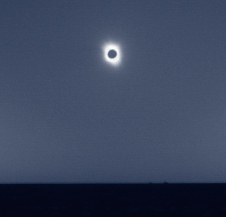
The solar eclipse of 4 December 2002 as seen from Woomera, South Australia. With its disc covered by the Moon, the Sun's outer atmosphere, known as the corona, comes into view. On 14 November there is another opportunity to see the eclipsed Sun from Australia. Photo Nick lomb
A TRANSIT AND AN ECLIPSE
6 JUNE Transit of Venus. People on the east coast of Australia and in New Zealand will be in the ideal viewing spot to see the rare sight of Venus crossing the Sun. They will be able to see the event from beginning to end, while for Western Australians the transit will already be in progress at sunrise. From Brisbane, Hobart, Melbourne and Sydney, Venus will first appear to touch the Sun's disc at 8:16 am Australian Eastern Standard Time (AEST) and then move across the disc as a small black dot until it leaves the Sun at 2:44 pm or 2:45 pm, depending on location. From Adelaide and Darwin, the transit begins at 7:46 am and 7:45 am ACST, respectively, and ends at 2:15 pm and 2:16 pm, respectively. From Auckland the transit begins at 10:16 am NZST and ends at 4:43 pm, with similar times for the rest of the country.
For more information and safety precautions see ASA Fact Sheet No 24 at www.astronomy.org.au.
14 NOVEMBER Total eclipse of the Sun . The eclipse will begin at sunrise in the north of Australia in Arnhem Land and cross Cape York before moving out into the Pacific (see diagram on ). Cairns in North Queensland is on the path of totality and this city and the surrounding region will provide the best locations to view the eclipse, weather permitting. From Cairns totality begins at 6:39 am AEST and lasts two minutes, occurring with the Sun low above the horizon.
The rest of Australia and New Zealand will experience a partial eclipse of the Sun at sunrise or later in the morning. From Brisbane 84% of the Sun's width will be covered by the Moon, from Sydney 67%, from Melbourne 52%, from Hobart 45% and from Adelaide 52%. From both Darwin and Perth the eclipse will start at sunrise, with 98% of the Sun's width covered from Darwin and 41% from Perth. From New Zealand the fraction of the Sun's width covered ranges from 87% in Auckland to 67% at Christchurch.

